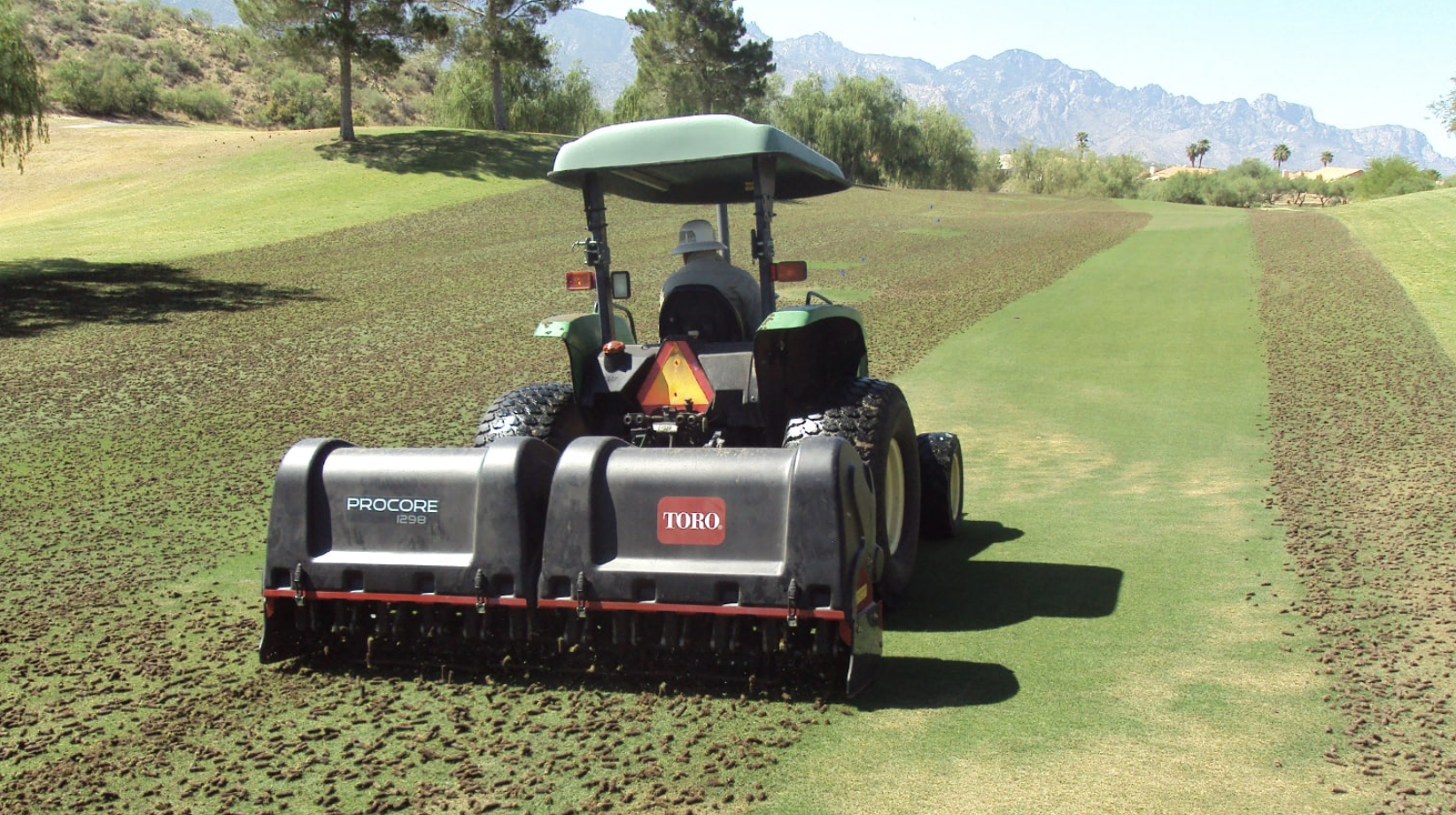USGA – West Update – Plan Your Summer Fairway Aeration Program
A study in New Zealand concluded that, “Beneficial effects of the twice yearly high pressure water injection cultivation and deep-tine cultivation treatments on soil physical properties and root growth were either extremely short-lived, or not yet apparent.” The study demonstrated the benefits of aeration, but also determined these benefits were only temporary. Multiple forms of aeration are beneficial and will improve infiltration rate, decrease compaction and improve gas exchange – but for how long, and which tools are best?
The USGA supported a fairway research study conducted in Arizona from 2006 through 2008. Findings from this research were similar to those in New Zealand – aeration does provide benefits, but the improvements are short-lived. To achieve sustained benefits, plan on multiple aeration events – i.e., a minimum of four to six times, and as much as 10 to 12 times per year if necessary – using a variety of tools such as solid or hollow tines, deep or shallow, slicing, linear decompaction with discs or “knives”, or sand injection. Consider the following when developing an aeration program:
Soil type
In fine-textured soil that is free of rocks, a deep tine machine able to penetrate 6-8 inches with solid or hollow tines can decrease surface and subsurface compaction and improve infiltration. Moreover, new linear decompaction tools that use large discs or knives will help to create deep channels and fracture the subsoil. However, in the rocky or granite-type soils that are frequently found in the southwest, deep-tining can be extremely challenging and expensive. In such cases, a PTO-driven linear decompactor that utilizes knives to drive through poor soil has been useful.
Speed
Achieving sustained benefits through the year will require multiple aeration events. Most courses must conduct aeration before morning play, so speed is important. A pull-behind aerator is an efficient tool for fast aeration. A 6-foot working width can cover as much as 50 acres per day. This type of tool generally pulls a 2- to 3-inch core or can be fitted with solid tines. Another tool is a pull-behind linear disc aerator. This tool can be outfitted with large discs able to reach a 6-inch depth, or with smaller discs and tighter spacing that can penetrate to about 2 inches. Finally, a pull-behind slicer unit is also fast and efficient. These tools can be used ahead of play in the morning and create little disruption.
Depth
Ideally, courses will use both deep and shallow aeration methods. If the goal is to perform four to six – or more – aeration events per year, it is unlikely that a deep tine can be used for all due to the slow pace of the operation. Benefits are derived from both deep and shallow aeration, so a combination of depths and tine types will be beneficial.
Tine Type
While one would think that hollow tines are best, research has not consistently demonstrated significant improvements when using a hollow tine versus a solid tine. Even slicing offers benefits. Therefore, focus on developing a program that allows you to achieve four to six – or more – aerations using multiple tools per year.
Sand Injection
Some machines create a linear slit in the soil and inject sand. The USGA-funded research previously mentioned evaluated one such tool. The benefits from using this machine were not found to be any different than a deep-tine aerator. Additionally, the surface soil will eventually seal over this sand slit with organic matter accumulation and soil movement, especially in clay soils prone to shrinking and swelling. While the buried sand may help roots and may improve gas exchange, the impact on soil water infiltration and ability to leach will be short lived. This is also a slow and expensive process; so while there may be benefits, you have to consider if this type of aeration fits into your budget and can be used multiple times each year.
Cost
Aeration machines can be quite expensive to purchase and maintain, especially on courses with very hard, compacted soils. Knowing that multiple events per year are necessary, consider a pull-behind aerator, pull-behind linear disk aerator and slicer for cost effectiveness, ease of maintenance and speed. Consider contracting a deep-tine aeration once or twice annually and supplement with these less expensive tools.
Fairway aeration is a beneficial and a very necessary part of an agronomic program. Recognize that one or two aeration events annually will not provide sustained benefits. A program using multiple tools, impacting different depths, with four to six events – or more – through the year will provide the long-term results you are looking for. Please do not hesitate to contact your regional USGA agronomist for more information on these strategies or any other agronomic practices.
References:
R. J. Gibbs, C. Liu, M.-H. Yang and M. P. Wrigley. 2001. Effect of Rootzone Composition and Cultivation/Aeration Treatment of the Physical and Root Growth Performance of Golf Greens Under New Zealand Conditions. International Turfgrass Society Research Journal. Vol 9.
West Region Agronomists:
Brian S. Whitlark, agronomist – bwhitlark@usga.org
Cory Isom, agronomist – cisom@usga.org
